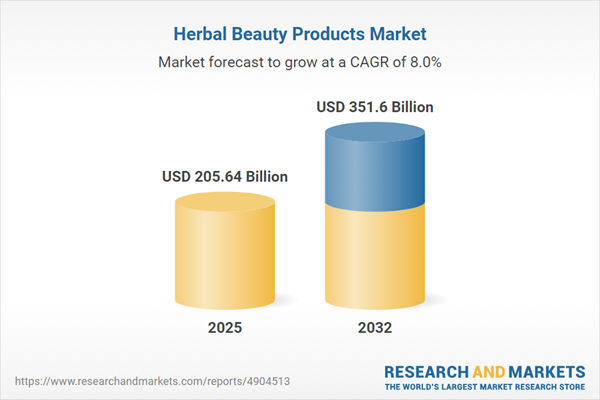Speak directly to the analyst to clarify any post sales queries you may have.
The herbal beauty products market is experiencing significant shifts as health-conscious consumers increasingly choose plant-based formulations with proven efficacy and safety. Industry leaders are navigating evolving consumer expectations, sustainability demands, and global regulatory changes that are redefining the landscape for manufacturers, distributors, and brands.
Market Snapshot: Herbal Beauty Products Market Growth and Opportunities
The Herbal Beauty Products Market grew from USD 190.28 billion in 2024 to USD 205.64 billion in 2025. It is expected to continue growing at a CAGR of 7.97%, reaching USD 351.60 billion by 2032. Driven by rising demand for natural ingredients and product transparency, the market’s trajectory is shaped by regulatory changes, innovations in formulation science, and shifts in global supply chains. Increased investment in research and development, coupled with consumer preference for botanical extracts, is fueling market expansion and segmentation.
Scope & Segmentation
This report provides a comprehensive analysis of trends, market drivers, and category growth across core segments:
- Product Types: Bath & body items (body lotion, body wash, soap bars), cosmetics (eyeshadow, foundation, lipstick, mascara), hair care (conditioner, hair mask, hair oil, shampoo), oral care (mouthwash, toothpaste), and skin care (face mask, face wash, moisturizer, serum).
- Ingredient Types: Aloe vera, neem, tea tree, and turmeric as foundational botanicals with health and efficacy benefits.
- Packaging Formats: Bio-based materials such as bamboo and paper; glass bottles and jars; metal containers including aluminum and tin; and various plastic bottles, jars, and tubes designed for convenience and sustainability.
- Distribution Channels: Direct sales (direct-to-consumer events, network marketing), online retail (brand websites, e-commerce platforms), pharmacies & drugstores (chain, independent), specialty stores (beauty retailers, spas, salons), and supermarkets or hypermarkets.
- End Users: Segments tailored to children, the elderly, men, unisex applications, and women, reflecting diversified care needs and formulation requirements.
- Geographic Regions: Coverage includes Americas (North America, Latin America), Europe, Middle East & Africa, and Asia-Pacific, each characterized by distinct regulatory, cultural, and supply chain factors impacting herbal beauty trends.
- Featured Companies: Analysis spans players such as Weleda AG, Mantra Herbal, Forest Essentials, Abhinav Healthcare Products, Everyday Herbal Beauty Care, Zoic Pharmaceuticals, Himalaya Global Holdings, Vasa Cosmetics, ASLI AYURVEDA, and Biofrank Pharmaceuticals.
Key Takeaways for Decision Makers
- Health-driven consumer preferences are fueling demand for botanical-based beauty solutions with a focus on transparency and efficacy. These trends are reshaping product formulation strategies and sourcing practices.
- Sustainability and ethical sourcing have become crucial competitive factors. Brands integrating eco-conscious packaging, circular economy practices, and responsible supply chains are building stronger trust with buyers and stakeholders.
- Emerging technologies in the herbal beauty sector, such as nanoemulsion and cold-pressed extraction methods, are extending the range and performance of active botanicals, enabling differentiated product experiences.
- Digital transformation is redefining distribution and consumer engagement, with omni-channel strategies leveraging AI-driven personalization and seamless online-to-offline experiences to reach new segments efficiently.
- Strategic alliances with research institutions and vertical integration are facilitating faster innovation cycles, quality control, and traceability—key requirements for success as the market matures.
Tariff Impact and Regulatory Change
The introduction of new United States tariff measures in 2025 is driving brands to reassess sourcing and procurement. Diversification of supplier networks and increased domestic manufacturing are emerging responses. Some companies are absorbing higher costs through localized investments or passing them to end consumers, while premium segments differentiate through stronger provenance and sustainability narratives.
Research Methodology & Data Sources
Our report leverages a rigorous mixed-methods approach, integrating executive interviews, consumer focus groups, quantitative surveys, and in-depth secondary research. Analytical models, including SWOT, Porter’s Five Forces, and value chain mapping, provide multidimensional insight for senior stakeholders evaluating the herbal beauty products market.
Why This Report Matters
- Enables leaders to benchmark product strategies and anticipate shifting market dynamics in the herbal beauty space.
- Offers actionable intelligence on regulatory compliance, supply chain resilience, and sustainability best practices.
- Supports innovation and portfolio decisions with verified insights into segmentation, technology adoption, and regional opportunities.
Conclusion
The herbal beauty products market presents abundant growth potential and evolving risks. Organizations prioritizing innovation, sustainable practices, and adaptive strategies will be positioned for resilience and leadership as market demands and regulatory landscapes continue to evolve.
Additional Product Information:
- Purchase of this report includes 1 year online access with quarterly updates.
- This report can be updated on request. Please contact our Customer Experience team using the Ask a Question widget on our website.
Table of Contents
3. Executive Summary
4. Market Overview
7. Cumulative Impact of Artificial Intelligence 2025
Companies Mentioned
The companies profiled in this Herbal Beauty Products market report include:- Weleda AG
- Mantra Herbal
- Forest Essentials
- Abhinav Healthcare Products Private Limited
- Everyday Herbal Beauty Care
- Zoic Pharmaceuticals
- Himalaya Global Holdings Ltd.
- Vasa Cosmetics Private Limited
- ASLI AYURVEDA
- Biofrank Pharmaceuticals (India) Pvt. Ltd.
Table Information
| Report Attribute | Details |
|---|---|
| No. of Pages | 194 |
| Published | October 2025 |
| Forecast Period | 2025 - 2032 |
| Estimated Market Value ( USD | $ 205.64 Billion |
| Forecasted Market Value ( USD | $ 351.6 Billion |
| Compound Annual Growth Rate | 7.9% |
| Regions Covered | Global |
| No. of Companies Mentioned | 11 |









